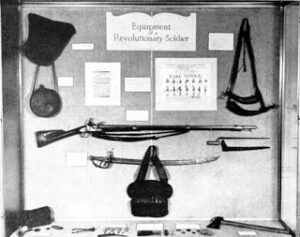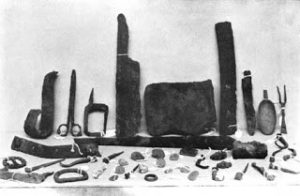Accouterments

This collection of equipment of the American soldier of the Revolutionary War includes a 1763 model Charleville musket, the regulation weapon of the French Army, with which most troops of the Continental Army were equipped by 1779. Felt hat, wooden canteen, powder horns, and ax are the other items in the case.
An order of April 6, 1779, issued in Boston and now preserved in the Emmet Collection of the New York Public Library, describes in detail the arms and accouterments of that day. A copy of it in the Morristown exhibit reads:
To Shrimpton Hutchinson Esq.
SIR,
You are hereby ordered and directed, to compleat yourself with ARMS and Accoutrements, by the 12th Instant, upon failure thereof, you are liable to a FINE of THREE POUNDS; and for every Sixty Days after, a FINE OF SIX POUNDS, agreable to Law.
Articles of Equipment,
A good Fire-Arm, with a Steel or Iron Ram-Rod, and a Spring to retain the same, a Worm, Priming wire and Brash, and a Bayonet fitted to your GUN, a Scabbard and Belt therefor, and a Cutting Sword, or a Tomahawk or Hatchet, a Poach containing a Cartridge Box, that will hold fifteen Rounds of Cartridges at least, a hundred Buck Shot, a Jack-Knife and Tow for Wadding, six Flints, one pound powder, forty Leaden Balls fitted to your GUN, a Knapsack and Blanket a Canteen or Wooden Bottle sufficient to hold one Quart.
The East Florida Ranger, therefore, would be expected to have, a leather belt, linen or cotton haversack, cartridge pouch, large knife, hawk or axe1, canteen and a blanket along with the personal accoutrements necessary to travel.
Firelocks2
The musket shown in the illustration (top of page) is the French Army regulation arm of the period, the Charleville model of 1763. It was selected for display for the reason that by the time the order quoted above was issued in 1779 virtually all the American Army was equipped with this type. Together with other French regulation muskets made at the Royal Arsenals of Maubeuge, St.-Etienne, and Tulle, which differed only slightly in design, it was the finest military arm of its day. Manufactured with greater care and having an improved type of hammer and barrel securely fastened to the stock by bands instead of “pins” through lugs, it possessed greater durability, accuracy, and range than did the British musket, or the colonial arms modeled from it, with which the Americans entered the war. The Charleville model was somewhat lighter than the British arm and its caliber was less, having a bore of about .69 inch.
If pressed, the trained Continental soldier could load and fire his piece four times a minute, but the rate generally was slower. He took little care in aiming, aware of the inaccuracy of his weapon except for short ranges. He swung his cartridge pouch to the front for greater accessibility; and between loading he thrust his ramrod conveniently into the ground beside him. His flint, if of good quality and adjusted properly between a fold of lead or leather in the jaws of the hammer, could be used 50 or 60 times. His handicaps were fouling of the barrel from powder combustion, which necessitated swabbing with the ramrod; and fouling of the flashpan and frizzen with clogging of the touchhole, requiring the use of a small iron brush and slender wire pick that usually were hung from the shoulder of the cartridge pouch or powder horn.
Powder and Cartridges
Musket cartridges, prepared by those skilled in their making, often were supplied to the troops from the ammunition laboratories. When they were not provided it was necessary for the soldier to “roll his own.” He melted his lead and poured it into an iron mold, forming balls which numbered 12 or 16 to the pound depending on the caliber of the musket in which they were to be used. The handles of the mold formed a snipping device intended for use in cutting off the “neck” of the bullet after molding; but the soldier usually preferred to smooth the leaden pellet with his jackknife.
Excavations at the site of the soldiers’ huts at Morristown uncovered many objects associated with the daily life of Washington’s fighters. Pothook, forceps, knife, fork, spoon, buttons, and buckles are among the items pictured here.

Into an oblong of tough paper, he placed the ball, sometimes with four or six buckshot, and four or four and one-half drams of coarse, black powder which he rolled into a cylinder, twisting or tying the ends. After receiving a coating of grease for protection from dampness, the cartridges were placed in separate borings in the wooden block forming part of the cartridge pouch and covered by its flap of leather. The pouch, suspended by a shoulder belt of webbing or leather, was worn behind the right hip and usually held 23 or 24 cartridges or “rounds of ammunition.” If the pouch and its contents became thoroughly wet during a rainfall or at a river ford, the soldier, except for his reliance on the bayonet, “hors de combat” (out of action) until his ammunition dried or a fresh supply of powder was obtained.
In order to load his musket when ammunition in the form of cartridges was used, the soldier brought the hammer of the lock to half-cock and uncovered the pan by pressing the frizzen upward and forward. Tearing or biting through the cartridge at its powder end, he filled the pan with powder, retaining it by closing the frizzen. Placing the butt end of the piece on the ground, he poured the remaining powder, together with the ball and paper as wadding, into the muzzle of the barrel and rammed them all well down with the rammer. Lifting the piece, he slapped it upon the stock opposite the lock in order to shake a small quantity of powder from the pan into the touchhole of the barrel. The piece then was ready to fire.
If loose powder carried in horns was used, the soldier poured down the barrel a quantity that he considered to be the correct charge, dropped in a lead ball taken from his pouch and, with a twist of tow as wadding, rammed all downward. The pan of the lock was filled from the horn the smaller one usually containing more finely ground powder for promoting better ignition. To fire the piece the hammer was brought to full-cock and pressure applied to the trigger. The hammer, holding securely in its jaws a piece of flint, was brought down by the force of the main spring, and the flint, striking the steel of the frizzen, threw it forward, uncovering the priming powder in the pan into which a shower of sparks was sent at the same instant. The sparks ignited the priming, and fire passed through the touchhole of the barrel and to the charge inside. The bullet then went wobbling on its way from the smooth bore toward its mark.
The range of military muskets of the period was between 400 and 600 feet, depending on their origin, weight of ball, and quality and charge of powder. Because of their smooth bores they had little accuracy but were intended primarily for volley-firing at a distance not exceeding 300 feet. Yet, when a ball hit its mark after being fired from a musket of .69 or .75 inch in bore (the prevailing bores of military arms of the period), it was capable, if not too well spent, of inflicting death or serious injury.
Clothing
The clothes worn by the East Florida Rangers are a composite of frontier style items, colonial militia and not necessarily British or Colonial uniforms. The basic items are as follows:
- a hat, brown or black, turned up on the left side – contains a cockade of white tail deer fur and a pin,
- a shirt made of linen or cotton (off white or natural color),
- a black leather stock, worn around the neck,
- a wool coat, usually with collar, cuffs, and lapels that were a different color or a rifleman’s frock in brown, gray or green,
- a waistcoat or vest, usually made of linen or wool,
- a pair of wool, linen, or cotton breeches that were gathered just below the knee,
- stockings, and gaiters to protect the socks in canvas or leather, and
- leather shoes.
Food
Even before a food supply system was organized for Colonial Troops, on June 10, 1775, the Massachusetts Provincial Council3 set the daily allowance or ration for its troops in Boston as:
- One pound of bread
- Half a pound of beef and half a pound of pork; and if pork cannot be had, one pound and a quarter of beef; and one day in seven they shall have one pound and one quarter of salt fish, instead of one day’s allowance of meat
- One pint of milk, or if milk cannot be had, one gill [half a cup] of rice
- One quart of good spruce or malt beer
- One gill of peas or beans, or other sauce equivalent
- Six ounces of good butter per week
- One pound of good common soap for six men per week
- Half a pint of vinegar per week per man, if it can be had.
George Washington’s well-appointed personal camp chest, or “mess kit,” enabled him to dine in a manner reflecting his position as commander of the Continental Army.

When in camp, the soldiers were housed in tents, except those in cold areas during winter; however, the basic plan was for six soldiers to share either a tent or a “hut” and, as at sea, the six created a “mess” or an eating unit which received the rations fit or available for six men and then cooked the food themselves.
Where soldiers had families on campaign with them, those women who were considered as companions for the men were also included in the rations and usually, they served as cooks for their mess. A Commissary General of Purchases was appointed by the Continental Congress to arrange for the purchase of rations and their transport.
In time, the ration changed due to problems with transporting the rations to the soldiers. For example, in spring of 1778, at Valley Forge, General Washington ordered that the 12,000 men encamped there, each was to receive daily: 1-1/2 pounds of flour or bread, 1 pound of beef or fish, 3/4 pound of pork, and 1 gill of whiskey or spirit; or 1-1/2 pounds of flour, 1/2 pound or pork or bacon, 1/2 pint of peas or beans, and 1 gill of whiskey or spirits, as or when they were available.
- colonials would have more likely used a hawk while British troops and/or East Florida Rangers would have used an axe [↩]
- http://contemporarymakers.blogspot.com/2010/09/weapons-and-equipment-of-early-american.html [↩]
- http://americanhistory.si.edu/blog/2013/05/what-did-soldiers-eat-during-the-revolutionary-war.html [↩]

